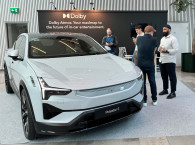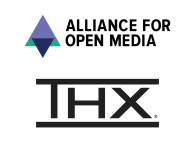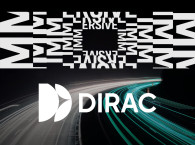
The 5th International Audio Engineering Society AES Conference on Automotive Audio that took place at the Uni3 Geely Center in Gothenburg, Sweden (June 26-28, 2024) was highly focused on the demonstration of immersive audio experiences in the car. With nearly 20 vehicles shipping or announced already featuring Dolby Atmos installations, many of which have been tuned and processed by Dirac, the Swedish company decided to promote a different experiment in cooperation with Google Open Media and Vaudeville Sound.
Complementing a keynote presentation by Jan Skoglund that was also promoted by Google Open Media to explain the goals and roadmap for the Immersive Audio Model and Formats (IAMF) initiative, Vaudeville created a full demonstration of the emerging possibilities unlocked by leveraging IAMF inside vehicle cabins, which Dirac enabled with a working installation.
Immersive Audio Model and Formats (IAMF), is Google's audio container specification offered under AOMedia's royalty-free license, and its open source reference software decoder, complete with test streams, are readily accessible on AOMedia's GitHub. When ready, IAMF will offer creator a full set of tools to craft immersive audio across a myriad of applications, from streaming and gaming to augmented reality and virtual reality, as well as traditional broadcasting.

For now, Google promotes the ability to carry and include multiple audio mix configurations and user controllable loudness adjustments for different playback preferences. There is also a vision to deliver both channel-based and scene-based Ambisonics spatial audio presentations to a wide range of devices, including headphones, mobile phones, televisions, soundbars and home theater systems.
IAMF provides means to signal rendering algorithms, such as EAR and BEAR, for playback in loudspeaker layouts and headphones. Thanks to existing open source plugins like the EAR Production Suite, which includes IAMF guidelines-compliant renderers for multi-speaker layouts and binaural monitoring, creators can explore immersive audio content creation and sound mixing as an alternative to existing commercially licensed formats such as Dolby Atmos, or rival open standard efforts such as MPEG-H 3D Audio, already widely embraced.

A demo car featuring a combination of IAMF, Dirac's automotive software solutions, and a Vaudeville Sound audio mix served to showcase all the channel-based creative possibilities in a vehicle equipped with speakers in an immersive audio configuration including headrests. According to Dirac, the AES demo showcased incredible sound opportunities afforded by immersive audio, paired with Dirac's sound optimization solutions.
"The car can be an excellent environment for experiencing immersive audio, with high end automotive sound systems often featuring 20 or more loudspeakers for highly optimized sound quality. However, no matter how sophisticated the system, there are certain acoustic challenges that hardware alone cannot overcome," explained Hendrik Hermann, Vice President Automotive at Dirac.
"By enabling all the speakers in a car to work intelligently together and co-correct each other’s impulse response, Dirac provides the best possible canvas for drivers and passengers to experience an engrossing spatial audio experience that will redefine the driving journey."

Given their expertise in immersive sound design and mixing, Vaudeville Sound was tasked with creating a combined multichannel and ambisonic IAMF audio mix, specifically for AES, to showcase the new audio experiences the IAMF can deliver in a car. Dirac then leveraged MIMO mixed phase impulse response correction and other patented technologies to ensure Vaudeville’s mix sounded its best.
Vehicle speakers often interfere with each other to cause distortion and reduce audio clarity – and systems with more speakers create greater interference. A car cabin's shape and materials can also lead to unwanted sound coloration, resulting in muddy, booming sound that makes it difficult to discern where sound is coming from. Dirac software removes these unwanted cabin effects to envelope drivers and passengers in a high-quality, immersive audio experience.
"As vehicles continue evolving to become quieter, more autonomous, and interconnected, new opportunities are emerging for automakers to craft audio experiences that forge deeper connections between vehicles, drivers, passengers, and their surroundings," added Jani Huoponen, IAMF product lead at Google. "By collaborating with Dirac on this world-first IAMF automotive demo, we’ve created the ideal foundation for AES attendees to experience the wonder of multichannel and ambisonic content just as it was intended from respected creators like Vaudeville Sound."
Dirac’s automotive audio solutions are currently used by leading automotive brands Volvo, Polestar, Genesis, NIO, BYD, and Hongqi among many others.
www.vaudeville.tv
www.aomedia.org
www.dirac.com








